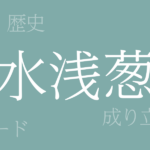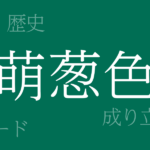Japan’s four seasons have produced numerous colors that change with their transitions. Among them, “錆浅葱” (さびあさぎ, Sabi-asagi) is a traditional Japanese color with a unique depth and quiet brilliance closely intertwined with Japanese aesthetics. This article delves into the allure of Sabi-asagi, exploring its history, color codes, and Western name.
About 錆浅葱 (さびあさぎ, Sabi-asagi)
錆浅葱 (さびあさぎ, Sabi-asagi) is a traditional Japanese color with a distinctive blend of blue and green. The term “錆” refers to the brownish color formed when metals oxidize, while “浅葱” signifies a light shade of blue. The combination results in a calm tone with depth.
History of 錆浅葱 (さびあさぎ, Sabi-asagi)
錆浅葱 (さびあさぎ, Sabi-asagi) has been used since the Heian period, adorning Japanese clothing and artworks. Particularly esteemed in the warrior society, this color was favored for its dignified hue, seen in samurai attire. It’s also featured in traditional performing arts like Noh and Kabuki, enhancing Japan’s unique aesthetic.
Color Codes for 錆浅葱 (さびあさぎ, Sabi-asagi)
In modern times, color codes are used to represent 錆浅葱 (さびあさぎ, Sabi-asagi) in digital and web design. Here are the primary color codes for Sabi-asagi:
- HEX: #5C9291
- RGB: R:92 G:146 B:145
- CMYK: C:68 M:34 Y:44 K:0
Western Name for 錆浅葱 (さびあさぎ, Sabi-asagi)
The Western name for 錆浅葱 (さびあさぎ, Sabi-asagi) would directly translate to “Rusty Light Blue,” although there isn’t a precise Western equivalent for this color. However, colors like “Slate Gray” or “Steel Blue” bear resemblance and can serve as reference points.
Summary of 錆浅葱 (さびあさぎ, Sabi-asagi)
錆浅葱 (さびあさぎ, Sabi-asagi) evokes Japan’s tradition and history. Its unique hue continues to be incorporated into modern designs and fashion, radiating new charm. In the digital age, utilizing its color codes can spread Japan’s traditional colors worldwide. 錆浅葱 has been beloved by Japanese for centuries and will continue to be cherished by many in the future.

























